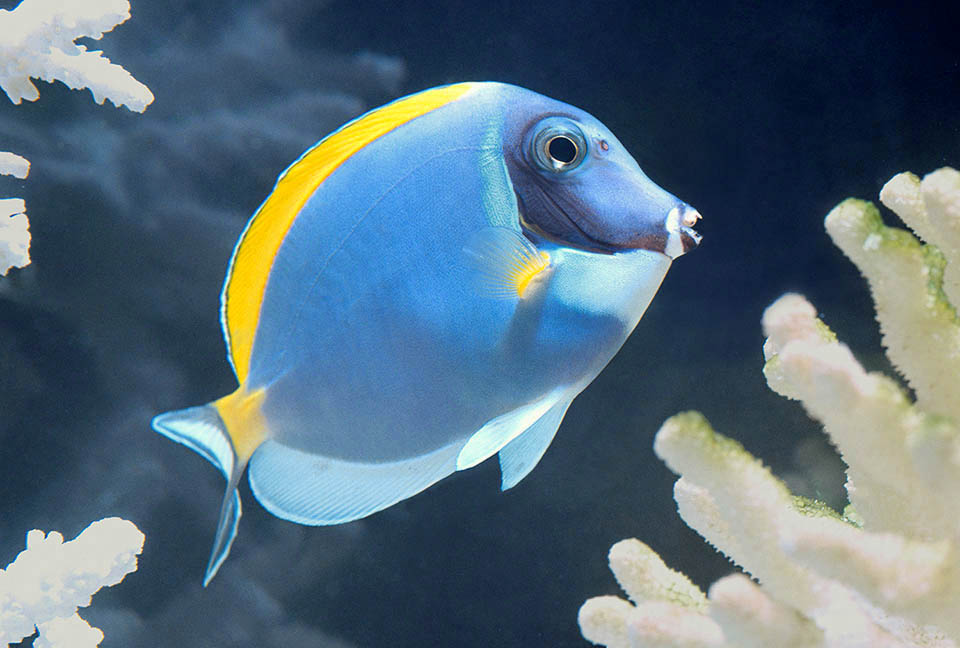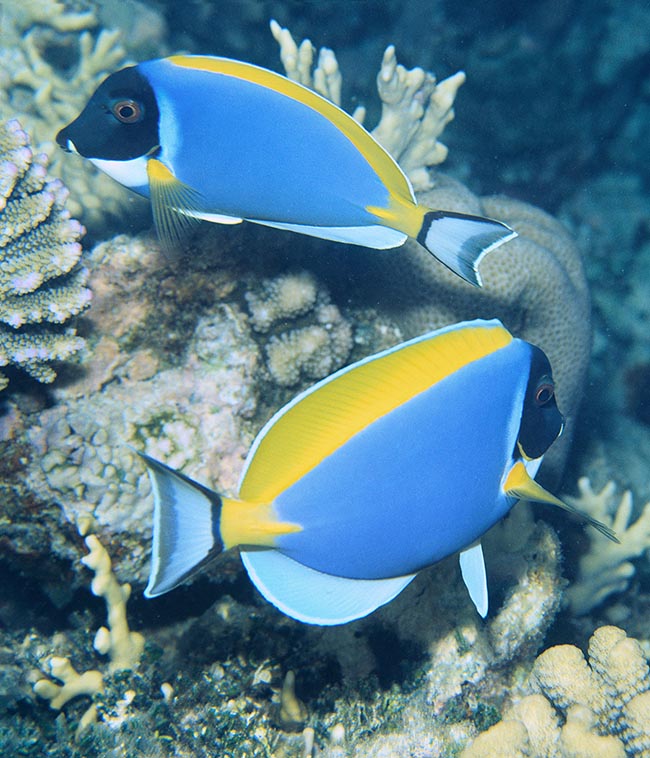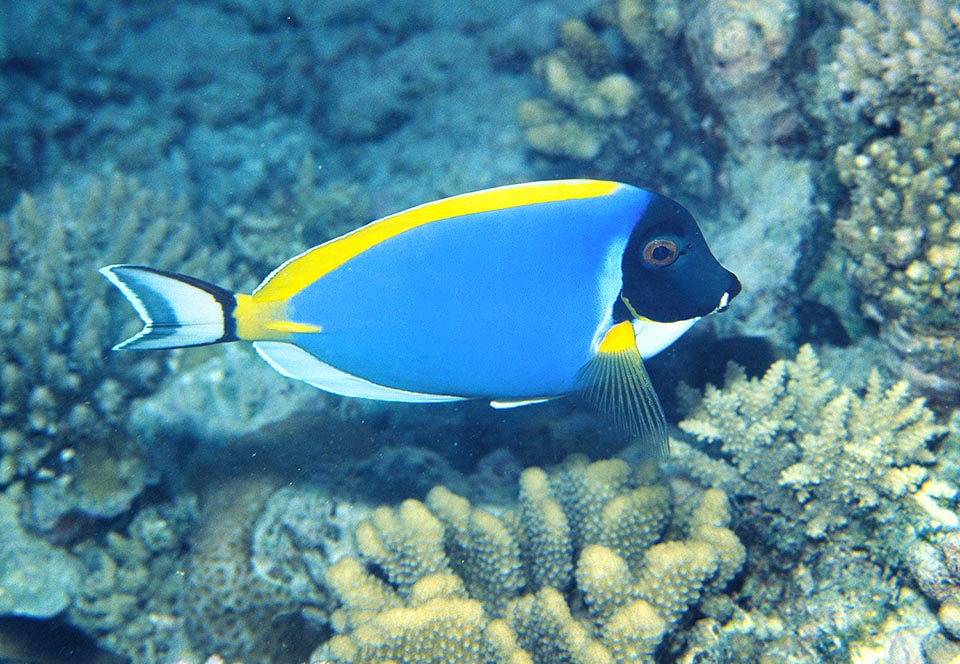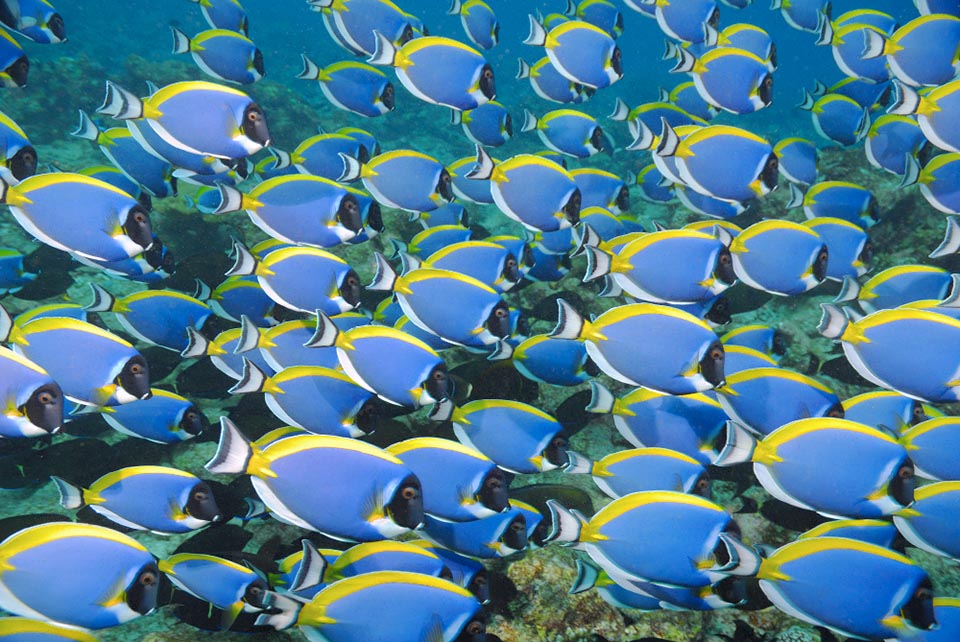Family : Acanthuridae

Text © Giuseppe Mazza

English translation by Mario Beltramini

About 20 cm long, Acanthurus leucosternon is present in the tropical waters of the Indian Ocean and nearby Pacific Ocean zones up to Indonesia © Giuseppe Mazza
The Powderblue surgeonfish, known in Italy as Surgeonfish with the white chest, (Acanthurus leucosternon Bennett, 1833), Actinopterygii, the ray-finned fishes, to the order of Perciformes and to the family of the Acanthuridae.
The name of the genus Acanthurus comes from the Greek “akantha”, spine, and “ura” = tail, due to the corneous spine, sharp as a razor, these fishes carry on both sides of the tail. The name of the species leucosternon comes from the Greek “leykos” = white and “sternon” = chest, as indicated by the Italian name.

It swims all day in shallow waters, cleaning the madreporic formations from infesting seaweeds © Giuseppe Mazza
Zoogeography
The Acanthurus leucosternon is at home in the tropical waters of the Indian Ocean, from South Africa to Somalia, Madagascar, India, Maldives, Sri Lanka, Indonesia up to the northern regions of Western Australia. It is present, in small number, along the Arabian Peninsula and is absent in the Red Sea.
Ecology-Habitat
It lives amongst the madreporic formations, preferably in the plain part of the reefs, where the seaweeds of which it nourishes do proliferate, but it wanders also on the precipices, without going down beyond the 25 m.
Morpho-physiology
The body, blue with the black head and the white chest, is flat and can exceed half a metre, even if the average size is approximately of 20 cm.
Higher on the front, it assumes with the stretched fins an almost oval shape. The long yellow dorsal, edged of white, with a thin black line between the two tints, counts 9 spiny rays and 28-30 soft; and the anal, symmetrical but shorter, is white with 3 spiny rays and 23-26 unarmed ones. Also the ventral fins are white, of modest size, whilst the pectoral ones are yellow. The caudal, shaped like a crescent, shows elegant patterns which recall the colours of the fish, and from the yellow peduncle starts horizontally a corneous spine, sharp as a razor, which comes out from a yellow housing, in full sight against the blue of the body. This is an easy to remember detail for the predators that have experienced it. The mouth is small with only one row of incisors above and below.
Ethology-Reproductive Biology
The powderblue surgeonfish lives isolated as well as in crowded schools, during the migrations looking for the food, formed by the small benthic seaweeds growing among the corals.
It is a monogamous fish which reproduces starting from the 14 cm of length. The larvae go through several stages, repeatedly changing appearance with long dorsal spines. They do not at all look like the adults, so much that, in the past, they were thought to be another species.

Like all surgeonfishes, it uses as a defense a sharp blade that it pulls out of the protruding yellow case visible on the caudal peduncle © Giuseppe Mazza
It goes without saying that due to its beauty it is a prize catch for the aquarists, but by sure it is not suitable for the small domestic pools, where, being territorial and unable to stay motionless becomes rapidly aggressive.
Also its feeding is not easy: it needs to be given fresh or lyophilized seaweeds and some suggest a complement with larvae of Artemia salina and whisked mussels. Furthermore, it is very sensitive to a ciliate protozoon, the Cryptocaryon irritans, which causes the white spot disease.
So, it is better to leave it in its reef, or to host it only in the huge public aquaria, where, over time, comestible algae do form. And then it can not only survive, but can even contribute in the cleaning of the pool. It has never reproduced in captivity, but it can reach the 15 years of age.

It is not an endangered species. Is found grazing isolated or in dense schools, but reproduction is monogamous. Sold for home aquaria, it is suitable only for the public ones © Richard Merritt
Resilience is mediocre, with a minimum population doubling time of 1.4-4.4 years, and the fishing vulnerability index marks 42 on a scale of 100.
In 1985 the Acanthurus leucosternon had the honour of a stamp of the Principality of Monaco.
Synonyms
Acanthurus delisiani Valenciennes, 1835; Acanthurus delisianus Valenciennes, 1835; Acanthurus leucosternum Day, 1889; Hepatus leucosternon Bennett, 1833; Rhombotides leucosternon Bennett, 1833.
→ For general information about FISH please click here.
→ For general information about BONY FISH please click here
→ For general information about CARTILAGINOUS FISH please click here.
→ To appreciate the BIODIVERSITY of BONY FISH please click here.
→ To appreciate the BIODIVERSITY of CARTILAGINOUS FISH please click here.
